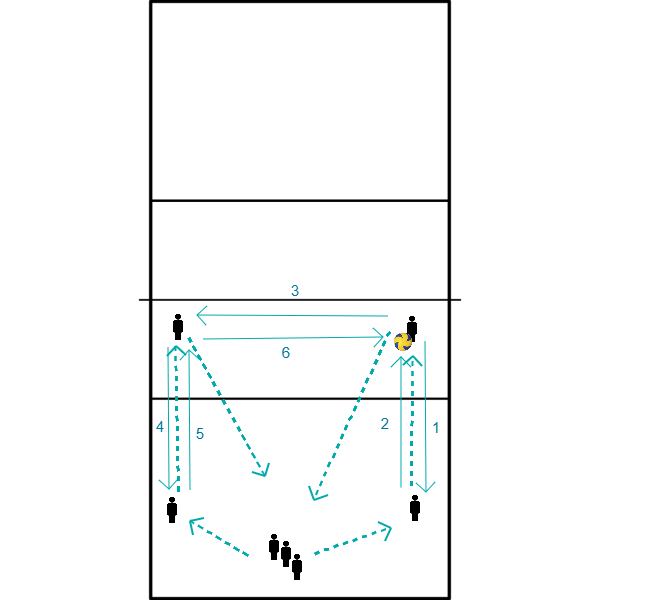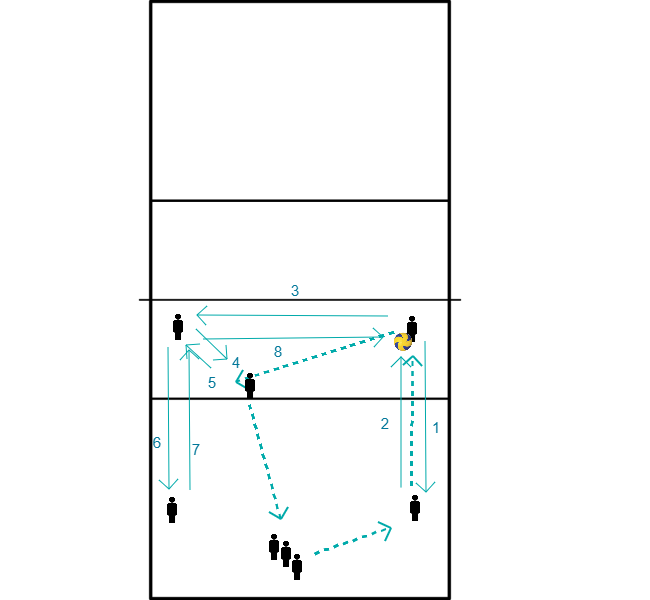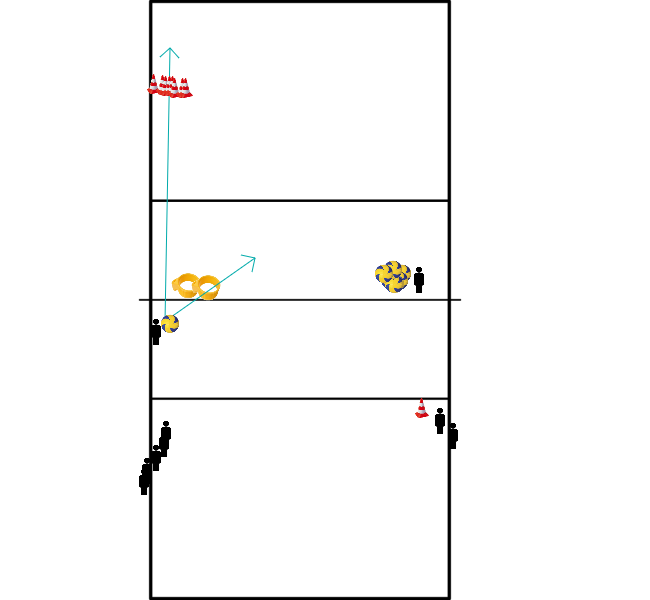Volleyball exercises for u21

- fixed line is ball direction: 1BH; 2pass; 3BH; 4BH; 5pass; 6BH
- vary the difficulty of ball 1 and 4
- when you reach the net you make a block jump
- broken line is running direction

- solid line is the ball direction: 1BH; 2pass; 3BH; 4tip; 5pass; 6BH; 7pass; 8BH; 9tip; 10pass
- vary in difficulty 4 and 9 || ball 1 and 6 hit ball
- broken line is running direction
After each part, a short rest and then through again. Parts with * need a bench, 2 to 4 persons per bench
- Part 1:
- 30 step-ups* (getting on/off the bench)
- 15 push-ups* (feet on the bench)
- 30 step-ups*
- Part 2:
- 30 east-west step-ups* (right foot on bench left foot next to it â€" left foot on it right foot next to it)
- 10 squats jumps (bend knees and jump as high as possible while stretching)
- the number of players present are all outside the field of play.
- In the middle of the field there is a hoop with a number of balls in it.
- 1 less than the number of players
- Players do a number of exercises, for example
- planking
- sit-ups
- push-ups.
- when the players have completed these exercises, they lie on their backs.
- At the sign of the trainer they run to the middle, and try to conquer a ball.
- They keep on running until there is only one ball left.
- The winner of the game decides on a punishment for the other players.
- Put 6 hoops down, on the 6 positions. (P1 t/m 6).
- Make 2 fair teams, easiest is from 4 players per team.
- One person from each team starts in the hoop at position 1.
- The rest of the team stands with a ball on the other side of the hoop, behind the back line and vice versa.
- As soon as the trainer indicates it, both teams start serving on the hoops.
- The person standing in the hoop tries to catch the service without stepping out of the hoop.
- When a service is caught, the person who served the ball moves to position 2, to catch the ball in the hoop.
- The person who was in position 1 goes to his own backline to serve.
- The team that catches the ball first at position 6 is the winner.
- Important is to concentrate on a good service every time.
- The goal of this exercise is to tactically put away or hit the ball.
- This by means of a tap ball on midmid, or a ball deep on position 1.
- By using baskets you can create a 'constant' block, which eventually can be replaced by a real block.
- The pawns at position 1 can best be replaced by a cupboard, over which the ball must fall, over the 'defender'.
- The trainer hits a ball, or plays a ball in, which is first passed to the distributor,
- the playmaker gives a set-up to the outside.
- The attacker decides whether to try a short passed ball at midmid (where there is a hoop),
- or looks for position 1 with a hit or a fast overhand ball.

- Play fanatically in pairs
- Make long series.
- Is that going well?
- Try to hit the ball quietly every now and then.
- Coach throws from the net:
- 3 players on the backline on their stomachs.
- Trainer hits the ball,
- 3 players stand up and trainer attacks/plays.
- Nr. 1 of the trio defends,
- No. 2 sets up and
- No. 3 attacks
- then next 3 team
- One player is tagged.
- When you are tagged, sit against the wall with one arm up. NOTE: legs in an angle of 90 degrees.
- When someone sits on your lap (=toilet) and "pulls" on your arm, you are free again.
- Change your ticker regularly.
- 5-minute laps around the field.
- Hamstring stretch.
- Ankle stretch.
- Groin stretch.
- Back stretch,
- Stand tall,
- step by step, hands on toes, starting with the chin on the chest.
- Then slowly go down to the toes.
- When the toes have been touched, slowly lift up and stretch all the way again.
- Planks on two elbows 3x20sec
- Planks on the side 2x20 left 2x20 right
- Push up 2x10
- Abdominals 2x10 Move elbows to knees.
- Warm up with ball
After each part, a short rest and then through again. Parts with * need a bench, 2 to 4 persons per bench
- Part 1:
- 30 step-ups* (getting on/off the bench)
- 15 push-ups* (feet on the bench)
- Part 2:
- 30 east-west step-ups* (right foot on bench left foot next to it â€" left foot on it right foot next to it)
- 10 squats jumps (going through the knees and jumping as high as possible when stretching)
- Part 3:
- 20 side shuffles over 4 meters
- 10 slit-squat jump (jump and go through 1 knee, other knee each time)
- Part 4:
- 30 step-ups* (stepping on/off the bench)
- 15 push-ups* (feet on the bench)
Part 1
- The players are divided into two equal teams.
- The balls are distributed equally on both sides of the net.
- The aim is to have as few balls on your own side as possible.
The way to pass the balls / course of play:
- Roll
- Throwing (overhand, underhand, one arm)
- Storage (underhand, overhand)
Part 2
- The trainer places a ball on the half way line.
- On either side of the net, a line of players stands at the back line.
- At the signal of the trainer they run to the ball, whoever has it may keep it.
Which team collects the most balls?
Variations:
- The players on both sides of the net are numbered (so that 2 players of the 2 different teams have the same number)
- Storm at sea: if your number is called, you must try to get the ball as quickly as possible and get back behind your line (= point + safety for the opponent).
- If you are tapped by your opponent when you have the ball in your hands, you have to drop the ball (you can pick it up immediately afterwards and continue playing).
- The trainer puts several balls on the middle line and everyone plays against everyone else and tries to collect as many balls as possible. (Several times, not as many balls as players, can also be played with a time limit, ...)
- The whole team sits against the wall
- The first one runs from the wall to the net and back and then sits against the wall again,
- Then the next player can run.
- They are not allowed to stop until the whole team has walked back and forth once.
- Afterwards the same exercise but with planks instead of sitting against the wall.








